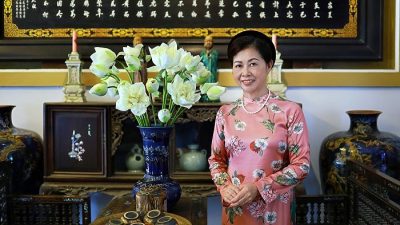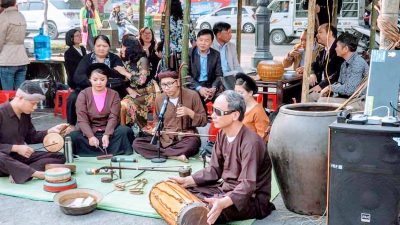
|
NDO – Vietnam’s revolution and senior patriotic photographers outlined a mission for Vietnamese photography: leaving studios to fight and directly write history through their lenses. |
|
They recorded history in a very honest and vivid manner, even through the blood and tears of both the people holding the cameras and the characters in the photos. The greatest value of the images that have been preserved until now is the existence of many photos which were taken chronologically. They directly and accurately recorded social events, the revolution’s turning points and outstanding people of the country. As a result, viewers can feel the national spirit and democracy of the Vietnamese people through the rally march on May 1, 1938, at the Grand Palais in Hanoi through Nguyen Ba Khoan’s photo; discover more about the mournful famine in 1945 through Vo An Ninh’s photo; and see the atmosphere of the August Revolution and the sacred and solemn scene of the ceremony marking Independence Day on September 2, 1945, at Ba Dinh Square in Hanoi through the records of photographer Vu Nang An. Since then, Vietnam’s photography sector has gone along with the nation during the fights for national construction and defence. At the beginning of the fight against French colonialism, photographer Nguyen Ba Khoan took a set of photos on the resistance war in the southern battlefield. when he came to the north, “Cuu Quoc” (National Salvation) Newspaper enlarged his nearly 500 photos for display at an exhibition. After that, an exhibition was held in Hanoi to introduce his 200 photos on the war in the central and central highland region. When the French army conducted aggressions in Hanoi and Hai Phong, photographers such as Ngo Le Dong, Nguyen Ba Khoan, Nguyen Tien Loi, To Na and many others joined the Capital Regiment and other military units, cultural agencies and newspapers to take historical photos while combating against the enemy. “The resistance war in the south”, “Hanoi through 60 days and nights of fire” were the series of photos that opened the heroic history chapters through the photographs later. For example, Le Van Thi captured the Vietnamese army’s combat against the French in Bau Ca, Dong Nai Province (1947). Tran Dang Lan recorded the image of Vietnamese soldiers intercepting a French military train when it was leaving Bien Hoa Station in 1947. Nguyen Van Phu took a photo story of local soldiers destroying the French station in Soc Trang Province to control the national highway in 1950. Photographer Mai Loc recorded the enemy’s crime of beheading Vietnamese guerrillas in My Tho, Ben Tre Province, in 1949, while Khuong Me’s photos featured Battalion 307 attacking Moc Hoa Station to destroy the enemy’s rescue attempt and capture French Chief Bertrand alive. In central region, the fierce Binh Tri Thien battlefield was thoroughly followed by photographer Bui A. The French army repeatedly attacked the Viet Bac region (which included the six provinces of Ha Giang, Tuyen Quang, Bac Kan, Lang Son, Thai Nguyen and Cao Bang) in order to destroy Vietnam’s resistance base. However, the deeper they attacked, the more severe they failed. Vu Nang An’s photo on Uncle Ho working at Dong Khe battlefield made its debut in 1950. The photos on Dien Bien Phu historic campaign in particular, which were taken by photographers Trieu Dai, Ngoc Thong and Nguyen Dinh Uu from Quan doi nhan dan (People’s Army) Newspaper, were highlights at that time. In addition to the images of the fights outside the front, photographers also paid attention to the lives of people from all ethnic groups in the free regions as well as the patriotic emulation movements of people from all strata. Photos on the fighting fences in the villages, the popular classes to eradicate illiteracy, children studying from backs of buffalo, military civil engineers making DKZ guns and mines themselves, etc, taken by Hong Nghi, Dinh Dang Dinh, tran Phuong, Van Khiem, Dinh Thuy and many others, showed the strong changes of the rear. Ending the nine years of arduous resistance war, Hanoi’s people held flowers and national flags to welcome soldiers to take over the capital on October 10, 1954. Dozens of professional and amateur photographers recorded the important event enthusiastically. Reporters Nguyen Dinh Uu and Bui Duy Ly from Quan doi nhan dan Newspaper and Nguyen Ba Khoan from Cuu Quoc Newspaper as well as many others photographers such as Nguyen Duy Kien, Phan Xuan Thuy, Than Trong Ninh, Nguyen Du and Dao Trinh captured many valuable photos of the historic moment. In order to fulfil the tasks of building socialism in the north, liberating the south and reunifying the country, the State invested and managed the photography sector in a public form. The Photography Division of Vietnam News Agency, which was formed in 1959, becasme the largest photo propaganda agency in the country, creating a new strength for Vietnamese photography. In addition to the development of photography activities in Vietnam News Agency and the Nhan Dan (People’s), Quan doi nhan dan, Cuu Quoc, Tien phong (Vanguard) and Hanoimoi (New Hanoi) newspapers, the photography of cultural departments in the localities were also strengthened and developed. As a result, the big, small and important events nationwide were not missed. The campaigns of cooperation of agriculture and handicraft in the south; the images of the US and quisling troops sweeping down villages and shooting guerrillas and civilians in the south; the Spring Mau Than 1968 General Offensive and uprising across the south; Khe Sanh Campaign; 12 days and nights of Hanoi and Hai Phong fighting with the US army’s B52; and the Paris Agreement on Vietnam were all captured fully through the photos. The photos featuring the image of Vietnamese soldiers taking over the Independence Palace on April 30, 1975, expressed the pinnacle of the victory. The southwestern border war and the battle to protect the north border in 1979 were also recorded thoroughly and honestly. They are pieces of undeniable historical evidence. Another special value of photography is the representation of typical people, circumstances and events of the life. The images of farmers, workers, soldiers and intellectuals were “carved” into the nation’s cultural monument as the people who made history thanks to the photographs. The photo, featuring a group of soldiers who were dressed in defence gear, held lunge mines and were willing to crash into French enemy’s tanks, became a symbol of indomitable Hanoians. It was a model for the sculptors to build a statue of death-braving soldiers on Dinh Tien Hoang street, near Hoan Kiem lake. Also, during the years of fighting against French colonialism, Nguyen Tien Loi was successful with his photo entitled “Xung phong” (Charge), which was taken during the Song Thao Campaign in 1949. It clearly showed the mettle of Uncle Ho soldiers entering the battlefield barefoot with guns to combat the enemy. Such heroic images are more and more during the resistance war against the US imperialism. Vu Tao’s photo on the scene of anti-aircraft artillery soldiers calmly releasing bullets to fight back the jet aircraft of the US army to protect Phu Lang Thuong Bridge left an indelible impression on viewers. Two exploded bombs created giant poisonous mushroom clouds in the sky, one silver and one thick black. Photographer Luong Nghia Dung’s photo on the gunfire at Doc Mieu highlighted two gunners suddenly jumping straight into the artillery dock pulling the trigger to retaliate against the American artillery from Con Tien, Doc Mieu and the 7th Fleet at sea hitting the battlefield. Meanwhile, Van Bao’s photo entitled “From the thunder god to buffalo carriage” proved the disastrous failure of the US air force. Behind the victories were the sacrifices of blood, houses and assets of Vietnamese people. The photo “Phuc Tan calling for revenge (in Hanoi)” hurts viewers’ hearts with the image of a 11-12 year-old girl screaming in front of her house which was destroyed by the US army’s bombs. Such photos were the screams of indignation condemning the non-sensical war. The photo was shot by one person. However, the success of photo in the press was thanks to the important contributions by the operational system behind it. On the occasion of the Great Spring Victory in 1975, many photographic reporters were deployed in the provinces from Quang Tri to Ca Mau and two groups of photographers were added in Saigon. The Deputy Editor-in-chief of Vietnam News Agency Tran Thanh Xuan established a “headquarters” in Lo Go, Tay Ninh, to direct the reporters in the whole region. However, Editor-in-chief Dao Tung still did not want to direct anyone to Hanoi. On April 2, 1975, he led a group of special photo reporters to went to Tay Ninh and Saigon. In the evening of April 30, 1975, he reviewed directly the photos on the liberation of Saigon and sent telephotos from Tay Ninh to Hanoi so that they could be transferred abroad and to domestic newspapers. Two reporters Ngoc Dan and Hoang Them took 18 film rolls to Da Nang airport on the afternoon of May 2. With the consent of his superiors, Hoang Thiem immediately boarded the transport plane C130 alone to take the film rolls to Hanoi. In Tay Ninh and Hanoi, the head and deputy head of the national news agency urgently worked together to promptly provide the people both in the country and abroad with historical photos highlighting the country’s glorious victory. Source: Nhan Dan Online |

